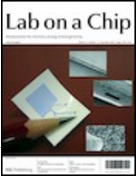Cell manipulation: Microfluidic syringe infusion & withdrawal pump
Injection of cell suspension to electroporation microchip by VIT-FIT syringe pump through teflon tubing at flow rate 4 μl/min: 2007
Low voltage DC electroporation chip with polyelectrolyte salt bridges.
Kim, Sang Kyung, Jae Hyun Kim, Kwang Pyo Kim, and Tack Dong Chung. In Micro Electro Mechanical Systems, 2007. MEMS. IEEE 20th International Conference on, pp. 465-468. IEEE, 2007.
Korea Institute of Science and Technology, Korea.
Keywords: bioMEMS, biological techniques, cellular biophysics, GFP plasmid expression, GFP plasmid transfection, K562 human chronic leukemia cells, electric potential, electrode reservoir, electropermeation, electroporation microchip, ionic conductivity, low voltage DC electroporation chip, pDADMAC, poly diallyldimethylammonium chloride, polyelectrolyte hydrogel, polyelectrolyte salt bridges
![]()
Abstract: Our electroporation microchip precisely controls the electric field on cells without bubble generation in microchannel by utilizing ionic conductivity of a polyelectrolyte hydrogel. pDADMAC (poly diallyldimethylammonium chloride) delivers electric potential from the electrode reservoir to the cells in microchannels Bubble generation is completely blocked without a high voltage source or a pulse generator . According to the calculation with CFD-ACE, the electric field across the salt bridges is around 1.3 kV/cm which meets the general electropermeation field strength (0.3-1 kV/cm).
Precise control of buffer and particle stream by VIT-FIT syringe pump in a cell separation system using 3D-asymmetric microelectrodes: 2005
An efficient cell separation system using 3D-asymmetric microelectrodes.
Park, Jungyul, Byungkyu Kim, Seung Kyu Choi, Su Hong, Sang Ho Lee, and Kyo-Il Lee. Lab on a Chip 5, no. 11 (2005): 1264-1270.
Microsystem Research Center, Korea Institute of Science and Technology, Seoul, South Korea.

Abstract: An efficient 3D-asymmetric microelectrode system for high-throughput was designed and fabricated to enhance sorting sensitivities to the dielectric properties—size, morphology, conductivity, and permittivity—of living cells. The principle of the present system is based on the use of the relative strengths of negative dielectrophoretic and drag forces, as in a conventional 3D-microelectrode system. Whereas the typical 3D-microelectrode system has a constant electric field magnitude due to the constant width of the microelectrodes and a fixed gap between face-to-face microelectrodes,
Flow in microchannels and at microhole was precisely controlled with two VIT-FIT microsyringe pumps: 2005
Design and fabrication of an integrated cell processor for single embryo cell manipulation.
Park, Jungyul, Seng-Hwan Jung, Young-Ho Kim, Byungkyu Kim, Seung-Ki Lee, and Jong-Oh Park. Lab on a Chip 5, no. 1 (2005): 91-96.
Microsystem Research Center, Korea Institute of Science and Technology, Seoul, South Korea and School of Electrical, Electronic and Computer Engineering, Dankook University, Korea.

Abstract: This paper presents an integrated cell processor for the automatic handling of individual embryo cells. The integrated processor can perform various functions such as cell transport, isolation, orientation, and immobilization. These functions are indispensable and frequently used for the manipulation of single cells, but can only be carried out by a skillful operator. The purpose of this study was the integration and automation of these functions for effective cell manipulation, using a MEMS approach. The isolation of a cell was performed using polypyrrole (PPy) valves in a microchannel into which cells were transported.
Integrated Bio Cell Processor using two programmable VIT-FIT microsyringe pumps: 2004
An integrated bio cell processor for single embryo cell manipulation.
Park, Jungyul, Seng-Hwan Jung, Young-Ho Kim, Byungkyu Kim, Seung-Ki Lee, Byungkwon Ju, and Kyo-Il Lee. In Intelligent Robots and Systems, 2004.(IROS 2004). Proceedings. 2004 IEEE/RSJ International Conference on, vol. 1, pp. 242-247. IEEE, 2004.
Microsystem Research Center, Korea Institute of Science and Technology, Seoul, South Korea.
Keywords: Biomanipulation; Dielectrophoresis; Integrated bio cell processor; Microfluidic channel; Orientation control; Polypyrrole valve; Single embryo cell manipulation
![]()
Abstract: In this paper, we present a novel integrated bio cell processor to handle individual embryo cells. Its functions are composed of transporting, isolation, orientation, and immobilization of cells. These functions are essential for biomanipulation of single cells, and have been typically carried out by a proficient operator. The purpose of this study is the automation of these functions for effective cell manipulation using a MEMS based bio cell processor. This device is realized with relatively simple design and fabrication process. To transport cells, microfluidic channel is employed. The isolation of a cell is performed by actuation of polypyrrole (PPy) valves.
VIT-FIT microsyringe pumps with infusion and withdrawal function used to control the orientation of Zebrafish egg in microchannel: 2003
Microfluidic Control for Biological Cell Orientation.
Namkung, Young-woo, Jung-yul Park, Byungkyu Kim, Jong-Oh Park, and Jin-Oh Kim. 제어로봇시스템학회 국제학술대회 논문집 (2003): 2457-2460.
Korea Institute of Science and Technology (KIST), Korea; Kwangwoon University, Korea.
Keywords: Biological cell, Cell manipulation, Cell rotator, Microfluidic, Orientation, Zebrafish egg
Abstract: There is a great demand to manipulate biological cell autonomously since biologist should spend much time to obtain skillful manipulation techniques. For this purpose, we propose a cell chip to control, carry, fix and locate the cell. In this paper, we focus on the cell rotator to rotate individual biological cell based on a micro fluidics technology.